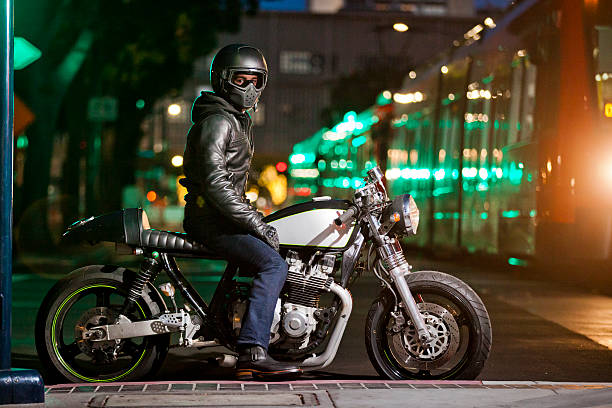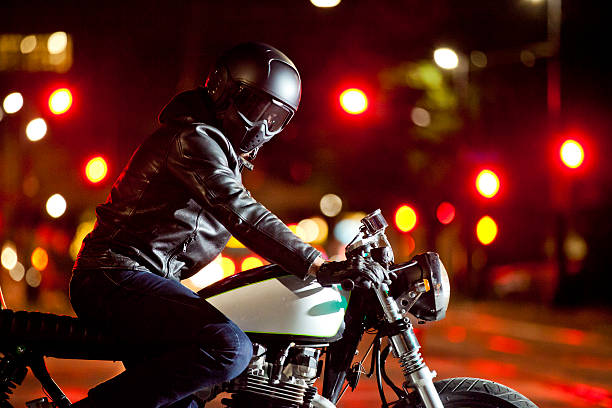Finding the greatest motorcycle leather vest involves appearance, function, and safety. These vests represent freedom and rebellion in motorcycle culture. The quality of the leather, fit, and style of the leather motorbike vest all matter when picking one.

The first important factor is the leather type. Motorcycle vests are usually constructed of cowhide, buffalo hide, or goatskin, each with its own qualities. Riders who value durability choose cowhide for its resilience to wear and tear. Buffalo hide’s heavier texture and grain pattern make it durable. While softer and more flexible, goatskin offers comfort and protection. Leather affects the vest’s appearance, feel, and performance.
The top priority is leather thickness and quality. High-quality, thick leather vests protect against weather and road abrasions. The vest’s thick leather makes it durable enough for daily usage. However, thick leather can be uncomfortable and hinder movement, so find a balance.
Another important consideration is vest craftsmanship. The vest’s durability and functionality depend on excellent seams, stitching, and hardware. Regularly used vests need strong seams and fastenings. The vest’s longevity and visual appeal come from meticulous manufacturing.
Vest fit is crucial for comfort and safety. A good motorcycle vest should be snug enough to remain on and not flap in the wind, yet loose enough to move and layer. Side laces or straps can be adjusted to match different body types. To ensure vest comfort on the bike, simulate riding positions when trying them on.
Functionality matters too. Riders appreciate vests with several compartments for wallets, keys, and phones. Internal pockets provide extra storage and are usually safer. Some vests have back protectors or armor pockets for added safety.
Personalization is important in motorcycle vest culture. Many riders decorate their vests with patches, pins, and other embellishments that reflect their personality, affiliations, and accomplishments. Many choose a vest that may be customized without destroying the leather.
Riders’ vests typically reflect their tastes and riding styles. Classic, basic vests to vests with complex tooling, studs, or fringe are available to suit all tastes. The vest’s style can express identity, making it an important choosing factor.
Make sure visibility and safety are considered. In low-light settings, reflective coatings or high-visibility components can help other road users notice the rider. Accident-prevention features can save lives.
Vest versatility is also important. Insulation for cooler weather and breathability for hot weather should make it suited for diverse riding conditions. A vest that can be worn year-round in diverse weather is more useful and valuable.
Leather vests need care to last. Leather needs regular cleaning and conditioning to stay soft. Knowing how to care for the vest’s leather and following maintenance instructions can extend its lifespan.
Environmental and ethical concerns are growing among riders. Selecting a leather vest from sustainable and ethical sources might be vital. This includes leather production’s environmental impact and animal welfare.

The type and quality of leather, craftsmanship, fit, utility, style, personalization options, visibility, versatility, maintenance, and ethics must be considered while choosing a leather motorcycle vest. The ideal vest satisfies the rider’s practical needs and matches their style and ethics. An essential traveling buddy, it protects, expresses, and lasts.
Traveling to Find the Perfect Motorcycle Leather Vest
Finding the right motorbike leather vest is more than just buying one. It’s a trip that combines personal style, functional demands, and motorcycle culture. A motorbike leather vest is a statement, symbol of independence, and expression of individuality. Finding the right motorbike leather vest includes considering quality, comfort, and personal style.
This quest begins with understanding motorbike vest leather types. Cowhide, buffalo hide, and goatskin are popular. Each leather kind has unique qualities and aesthetics. Riders who value durability and toughness will love cowhide. Buffalo hide is popular for its natural grain and feel. However, goatskin is lighter and more supple, offering comfort and flexibility without sacrificing protection.
The quality of the leather matters. High-quality leather lasts longer and protects better. It should be thick enough to resist abrasions but flexible enough for comfort. The vest’s appearance and aging depend on the leather’s texture, polish, and color.
The vest’s quality is evident. Stitching, seams, and hardware should be high-quality for durability and functionality. Check the vest for uniform stitching, durable zippers or snaps, and good lining. Well-made vests are comfortable, durable, and attractive.
Motorcycle vest fit is crucial. A good vest should be snug enough to keep out the wind yet loose enough to move and layer. Many vests have adjustable side laces or straps for a better fit. Consider wearing your riding gear when trying on vests to ensure an exact fit.
Functionality is key to the vest’s design. Look for features that meet your demands, such as the quantity and placement of pockets, which can range from basic external to secure interior ones. For more vigorous riding, some vests have added padding or armor.
Motorcycle vest customization is a biker tradition. Many motorcyclists decorate their vests with patches, pins, and needlework that reflect their personalities, connections, and riding experiences. Consider how your vest can tell your narrative. The vest’s design and material should allow personalization without harming the leather.
Riders’ vests typically reflect their tastes. The market has several styles, from simple cuts to sophisticated ones with tooling or fringes. Your vest should match your style and make a statement.
Safety and visibility are also important. Reflective materials or high-visibility accents can help other drivers notice you in poor light. These elements improve road safety and can save lives.

If you plan to ride in different situations, the vest must be versatile. It should insulate for cooler rides and breathe for hot rides. A vest that fits comfortably in all seasons and weather is a great riding accessory.
Leather vests need maintenance to last. To stay soft and attractive, leather needs frequent cleaning and conditioning. Proper care keeps the vest fashionable and protective while extending its lifespan.
Environmental and ethical factors are increasingly influencing purchases. A leather vest made from sustainable and ethical sources can reflect your values and promote responsible consumption.
In conclusion, buying a motorbike leather vest takes careful consideration of several elements. Each factor matters, from leather kind and quality to craftsmanship, fit, utility, style, personalization, visibility, versatility, and upkeep. The right motorcycle leather vest is more than simply a purchase—it’s a buddy on your excursions and a representation of your biking style.





Leave a Reply